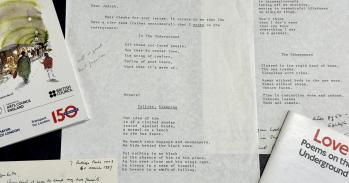
A conference at Cambridge University will explore the ways in which words and fabrics are stitched together in language and literature – and celebrate the means by which textiles carry hidden narratives in their warp and weft.
A conference at Cambridge University will explore the ways in which words and fabrics are stitched together in language and literature – and celebrate the means by which textiles carry hidden narratives in their warp and weft.
You simply can’t get to grips with literature as a material phenomenon without thinking about its relationship with the physical fabrics that surround us.
Jason Scott-Warren
In August 1992, the writer WG Sebald set off on the walking tour of Suffolk that he later immortalised in The Rings of Saturn. His journey took him through innumerable scenes of decline and decay—fading seaside towns, silted-up rivers, abandoned pleasure palaces, whole towns lost beneath the waves—and in the book those scenes prompt a series of meditations on human failure and folly.
Sebald’s melancholy East Anglian odyssey ends in Norwich, where he turns to consider the many silk-weaving workshops that once kept that city lit up until late into the night. Looking at the surviving 18th-century pattern books, lined with ‘marvellous strips of colour, the edges and gaps filled with mysterious figures and symbols’, he finds in them ‘an iridescent, quite indescribable beauty’. These pages , copies of which once travelled the trade-routes of Europe, ‘seem to be leaves from the only true book which none of our textual and pictorial works can even begin to rival’. In concluding his patchwork travelogue with this celebration of a silk sample-book, Sebald makes a connection that has deep roots in human cultures, between the textual and the textile.
Next week, an ambitious interdisciplinary conference in Cambridge will unravel the fascinating interplay between words and fabrics. Run by the University’s Centre for Material Texts, the two-day conference is the latest in a series on ‘the material text in material culture’; last year’s meeting considered the interplay between reading, writing and eating. “After ‘Eating Words’, there was a certain inevitability about “Texts and Textiles’,” says the Centre’s director, Jason Scott-Warren. “You simply can’t get to grips with literature as a material phenomenon without thinking about its relationship with the physical fabrics that surround us.”
The connection between texts and textiles begins in shared etymology; both words find their origins in the Latin verb texere, ‘to weave’. And that analogy between words and fabric continues to proliferate in our own everyday speech. We all know what it means to spin a yarn, or to lose the thread of a story. Every good plot needs a dénouement, an untying or unknotting, and from Ariosto to The Archers, narratives have benefited from entrelacement, the interlacing of several strands which can be left hanging at moments of crisis.
The textile metaphor has been picked up by literary theorists such as Roland Barthes, who in The Death of the Author insists that we should not attempt to decipher texts but should instead disentangle them: ‘the structure can be followed, ‘run’ (like the thread of a stocking) at every point and at every level, but there is nothing beneath’.
The textile arts not only allow us to think about how literature works; they are also involved in the very stuff from which books are fashioned—whether we think of the rags that make paper, the sewing together of pages, or the various materials employed in bookbinding. Textiles (and the women who have made them) are also the subject of many stories, whether we are talking about Homer’s Penelope, Ovid’s Philomela, or Tennyson’s Lady of Shalott.
And of course, the threads also run the other way. Samplers are only one of the many forms of fabric that have carried verbal messages, many of them moralising or improving. The recent exhibition of Quilts 1700-2010 at the Victoria and Albert Museum was subtitled ‘Hidden Histories, Untold Stories’. As well as displaying numerous quilts that had textual sources for their visual designs, or that had messages embroidered onto them, the V&A’s show also exposed the printed and handwritten texts that had been cut up to serve as templates or backing in the making of the patchwork. The patches on one 19th-century coverlet, celebrating a marriage, were rumoured to have been ‘pieced-in’ with the couple’s love-letters.
Tracy Emin’s infamous tent, ‘Everyone I have ever slept with 1963-1995’, which bore appliquéd names of her bedfellows from birth, offers a less romantic demonstration of the power of the stitched word. Meanwhile, even wordless textiles have a tantalising relationship with verbal culture, tempting us to ponder the ‘grammar of ornament’ or to decode the language of their decorative schemes. Of all fabrics, those used in clothing are perhaps the most legible. The ‘newspaper outfits’ used in the Olympics‘ closing ceremony may have been intended to celebrate the freedom of the British press but they also suggest the eloquence of what we wear, whether or not it boasts a designer label.
From artists’ books to knitting blogs, from ancient Greek lyric to the language of modern colorectal surgery, ‘Texts and Textiles’ will explore a huge range of perspectives on its theme, hearing not only from academics but also from practitioners who make their living from the warp and weft of words. The keynote speaker is the anthropologist Tim Ingold from the University of Aberdeen, whose work has reflected in fascinating ways on writing, stitching, storytelling and journeying. Doubtless the conference will leave many loose ends, but it promises to be an enthralling tapestry.
Texts and Textiles, a conference organised by the Centre for Material Texts, will take place on 11 and 12 September 2012 at Jesus College, Cambridge. For further information, contact the organisers, Lucy Razzall (lmfr2@cam.ac.uk) or Jason Scott-Warren (jes1003@cam.ac.uk).
This work is licensed under a Creative Commons Licence. If you use this content on your site please link back to this page.





